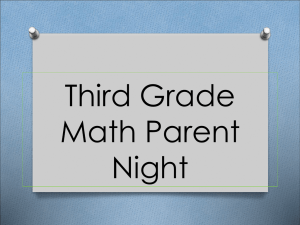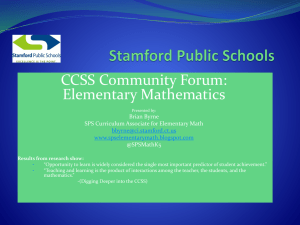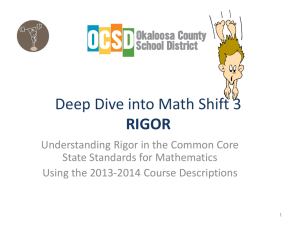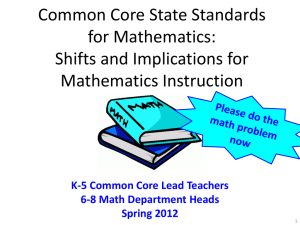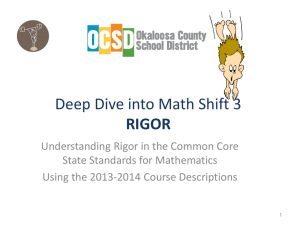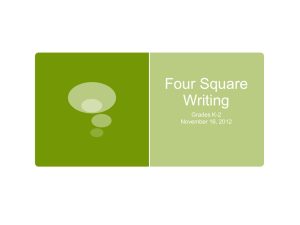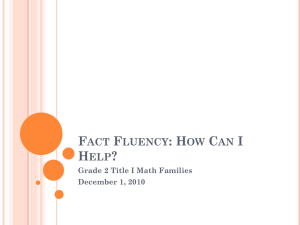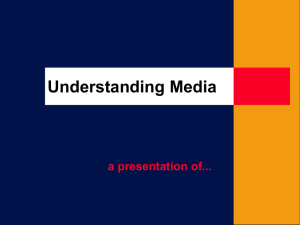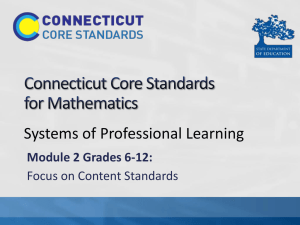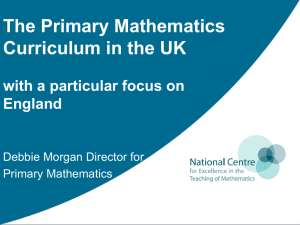MathCadre1stgradeRigor
advertisement
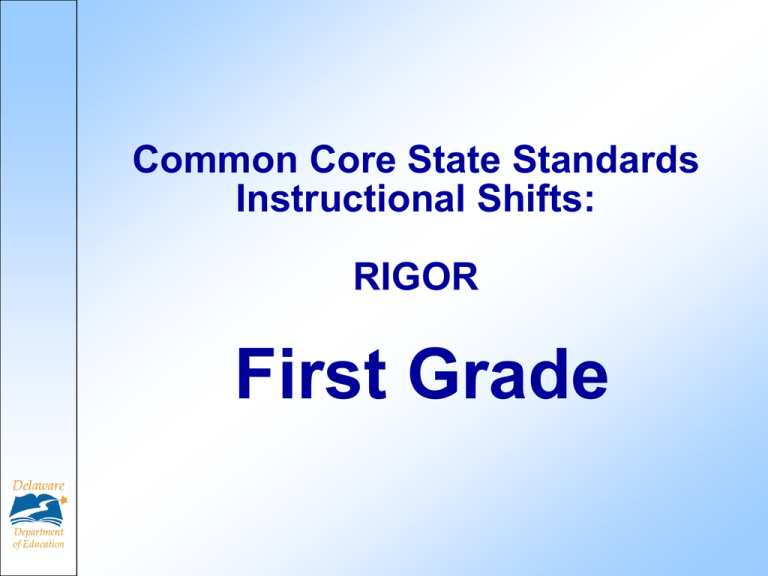
Common Core State Standards Instructional Shifts: RIGOR First Grade CCSS-Mathematics Overview What I already know about the Common Core State Standards. What I would like to learn about the Common Core State Standards. What I learned today about the CCSS and how I can apply this knowledge in my classroom. The Hunt Institute http://www.youtube.com/watch?v=dnjbwJdcPjE Common Core State Standards for Mathematics: Three Key Shifts CCSS Shifts Background 1. Focus: Focus strongly where the standards focus. 2. Coherence: Think across grades, and link to major topics. 3. Rigor: In major topics, pursue conceptual understanding, procedural skill and fluency, and application. The Why: Shift One Focus strongly where the Standards focus • Significantly narrow the scope of content and deepen how time and energy is spent in the math classroom. • Focus deeply only on what is emphasized in the standards, so that students gain strong foundations. The Why: Shift Two Coherence Think across grades, and link to major topics within grades • Carefully connect the learning within and across grades so that students can build new understanding onto foundations built in previous years. • Begin to count on solid conceptual understanding of core content and build on it. Each standard is not a new event, but an extension of previous learning. The Why: Shift Three Rigor In major topics, pursue conceptual understanding, procedural skill and fluency, and application • The CCSSM require a balance of: • Solid conceptual understanding • Procedural skill and fluency • Application of skills in problem solving situations • This requires equal intensity in time, activities, and resources in pursuit of all three. Procedural Skill & Fluency A Closer Look at: Rigor Rigor • A conceptual approach to learning mathematics in which students develop a depth of understanding by connecting meaning to procedures. • Requires a balance of: Solid conceptual understanding Procedural skill and fluency Application of skills in problem solving situations Conceptual Understanding • • • • • More than just “how to get the answer” Support ability to access concepts from a number of different perspectives More than a set of mnemonics or separate procedures Deep conceptual understanding of core math concepts Applying math in new situations and speaking about their understanding “Conceptual knowledge of mathematics consists of logical relationships constructed internally and existing in the mind as a network of ideas … By its very nature, conceptual knowledge is knowledge that is understood.” John Van De Walle (2004) Elementary and Middle School Mathematics Teaching Developmentally (Sixth Edition) ISBN 0-205-48392-5 The Math Progressions • Develop conceptual understanding • Support conceptual knowledge • Develop informal strategies to solve problems within the domain • Refine the informal strategies to develop fluency with standard procedures Frequently Asked Questions How can we assess fluency other than giving a timed test? • Is it really possible to assess conceptual understanding? What does it look like? • Aren’t the Common Core State Standards for Math all about application and meaningful tasks? Achievethecore.org 1st grade snapshot from Progressions for the Common Core State Standards in Mathematics, University of Arizona CCSS.Math.Content.1.NBT.C.5 CCSS.Math.Content.1.NBT.C.6 Non-example of conceptual understanding Procedural Skill and Fluency • Speed and accuracy in calculation • Class time and/or homework time is structured for students to practice core functions such as addition facts The Hunt Institute http://www.youtube.com/watch?v=ZFUAV00bTwA&list=UUF0pa3nE3aZAfBMT8pqM5PA Fluency Fluent in the Common Core State Standards means “fast and accurate.” It helps to think of fluency as meaning the same thing as when we say somebody is fluent in a foreign language: when you’re fluent, you flow. Fluent isn’t hesitancy, faltering, or reversing oneself. Grade Standard Required Fluency K K.OA.5 Add/subtract within 5 1 1.OA.6 Add/subtract within 10 2 2.OA.2 2.NBT.5 3 3.OA.7 3.NBT.2 4 4.NBT.4 Add/subtract within 1,000,000 5 5.NBT.5 Multi-digit multiplication 6 6.NS.2,3 Multi-digit division Multi-digit decimal operations Add/subtract within 20 (know single-digit sums from memory) Add/subtract within 100 Multiply/divide within 100 (know single-digit products from memory) Add/subtract within 1000 Application of Skills in Problem Solving Situations • Use appropriate concepts and procedures for application even when not prompted. • Apply math concepts in “real world” situations. • In content areas outside of math, particularly science, ensure students use grade-level-appropriate math to make meaning of and access science content. Depth of Knowledge Level 1 • Requires students to recite or recall of information including fact, formula, or simple procedure. • May be asked to demonstrate a rote response, use a well-known formula, follow a set procedure (like a recipe), or perform a clearly defined series of steps. Level 2 • Requires some mental processing beyond a habitual response. • Requires students to make some decisions on how to approach a task or problem Level 3 • Requires reasoning, planning, using evidence and in most cases to “explain their thinking.” • Requires students to go beyond; to explain, to generalize, or connect ideas Level 4 • Requires some complex reasoning, planning, developing and thinking over an extended period of time. • May be asked to develop a hypothesis and perform complex analysis Rigor in First Grade Operations and Algebraic Thinking 1.OA Jasmine has eight daisies and three vases - one large, one medium-sized and one small. She puts 5 daisies in the large vase, 2 in the medium vase and 1 in the small vase. Can you find another way to put daisies so that there are the most in the large vase and least in the small vase? Try to find as many ways as you can put the daisies in the vases with the most in the large vase and the least in the smallest vase. If you think you have found them all, explain how you know those are all the possibilities. Example of CCSS First Grade item found at: IllustrativeMathematics.org Number and Operations in Base Ten 1.NBT Louis wants to give $15 to help kids who need school supplies. He also wants to buy a pair of shoes for $39. If Louis gets $1 every day for his allowance, how many days will it take him to save enough money for both? Explain how you know. Example of CCSS First Grade item found at: IllustrativeMathematics.org Geometry 1.G How many rectangles are in this picture? Example of CCSS First Grade item found at: IllustrativeMathematics.org (NOT FOR ASSESSMENT!) Group Discussion Shift Three: Rigor In major topics, pursue conceptual understanding, procedural skill and fluency, and application Question One: “What does it mean for students to have a Conceptual Understanding and why is it important in the CCSS?” Shift Three: Rigor In major topics, pursue conceptual understanding, procedural skill and fluency, and application Question Two: “What is the Fluency expectation for First Grade and how are teachers supposed to support students their learning process of these?” Shift Three: Rigor In major topics, pursue conceptual understanding, procedural skill and fluency, and application Question Three: “What are the three key goals of the Application of Problem Solving? Hint: 1 applies to students and the other 2 apply to instruction. What I already know about the Common Core State Standards. What I would like to learn about the Common Core State Standards. What I learned today about the CCSS and how I can apply this knowledge in my classroom. Resources • www.corestandards.org • http://ime.math.arizona.edu/progressions/ • www.insidemathematics.org • www.teachingchannel.org • www.achievethecore.org • www.illustrativemathematics.org • commoncoretools.me Next Steps?
